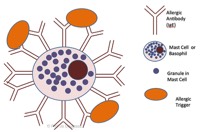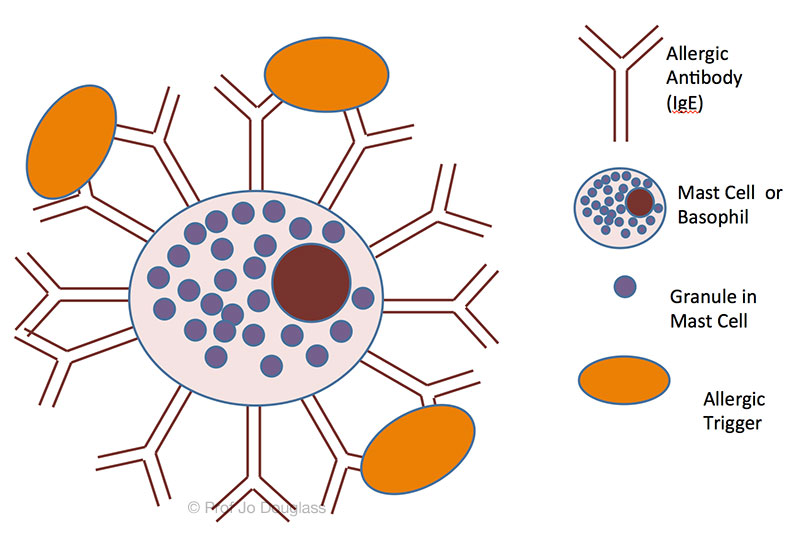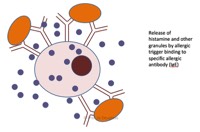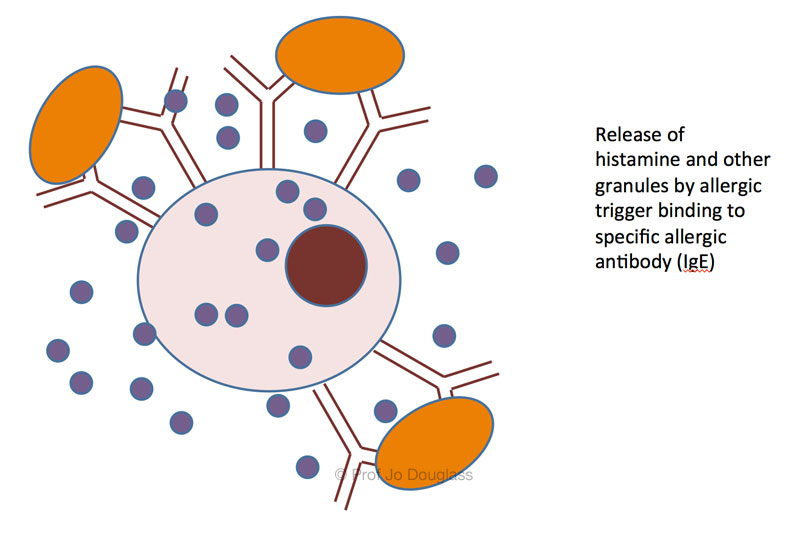News
Parkville Allergy, Asthma and Immunology Consultants have moved to new premises at Suite 123, 55 Flemington Rd. The practice is now named “Melbourne Allergy, Asthma and Immunology Consultants”. This move will enable expansion of clinical services offered with recruitment of nurses and dieticians to the practice as well as recruiting further specialist associates to provide excellent specialist care to people with Allergic diseases and Asthma – and reduce the wait for appointments.
Visit the new MAAIC website: www.allergyasthma.com.au
Anaphylaxis
Parkville Allergy Asthma & Immunology Consultants
Melbourne Allergy Clinic


What happens to cause anaphylaxis? Slide 1


What happens to cause anaphylaxis? Slide 2
Anaphylaxis occurs when histamine-containing cells in the body are activated by an allergic trigger binding to allergic antibody (IgE) on the surface of the cell. These cells release large amounts of histamine and other allergic mediators which have widespread effects. (Click images to enlarge)
a) Breathing difficulties
Breathing difficulties can be caused by swelling in the upper airway (larynx or voice box) which often begins as a hoarse voice or “lump in the throat” but can progress to cause blockage of the airway. Breathing difficulties can also be caused by asthma which can be triggered in people who suffer from anaphylaxis and is associated with severe reactions.
b) Low blood pressure leading fainting or collapse.
Low blood pressure will cause symptoms of faintness, dizziness, or in extreme cases collapse. This happens because of the release of histamine in the course of anaphylaxis which leads to low blood pressure.
c) Skin rash.
Anaphylaxis can start out as an extremely itchy skin rash which often starts in the hands, axilla and groin. Typically the rash will cause itchy welts, like hives. Some-times at the beginning of a reaction, the rash is just a severe flush or redness.
d) Vomiting or diarrhoea
Some people with anaphylaxis have vomiting and/or diarrhoea as part of their reaction. Whilst this may occur often in food allergies in the setting of mild reactions, vomiting or diarrhoea after an injected anaphylaxis trigger (such as an insect sting) is a sign of a very severe reaction.
Symptoms of difficulty breathing or low blood pressure are the most important symptoms of anaphylaxis because they can endanger life.
Anaphylaxis is a generalised severe allergic reaction, that is more than one body system is affected. It is usually caused when the body makes an allergic antibody (IgE) to a substance. When that allergic substance or “trigger” is encountered again, the IgE leads to massive release of histamine and other substances that can cause a severe allergic reaction in the body. The histamine causes blood vessels to dilate, leading to low blood pressure and tissue swelling which can lead to airway blockage. Histamine and other substances released during a severe allergic reaction can also provoke asthma, nausea and vomiting and skin rashes.
Most anaphylaxis does not result in death, yet anaphylaxis probably kills about 10 Australians every year, but the tragic thing about those deaths is that if the trigger could have been avoided, then the death would likely not have occurred. The most common trigger of fatal anaphylaxis reactions is medications, causing about half of deaths from anaphylaxis, whilst food allergy and stinging insect allergy make up most of the other causes.
In studies of anaphylaxis, about half are caused by medications. These are often medicines given intravenously such as antibiotics and general anaesthetics or pain-relieving medications.
The next most common cause of anaphylaxis is insect stings. In Australia honey-bees cause most of the severe reactions to insect stings, but other insects that are important are Jack Jumper Ants, paper wasps and European wasps. It’s odd to think that the most dangerous Australian animal, year on year, is the honey-bee!
Foods are often mentioned in media reports and are often top of the list in terms of community awareness and concern. The most common food associated with severe reactions is nuts including peanuts and other tree nuts. In children egg, milk and wheat can be important, whilst in adults shellfish and fish along with seeds are the most important foods to which people are allergic.
Sometimes no obvious cause for anaphylaxis can be found, whilst some people react to unusual triggers such as latex rubber, exercise or temperature changes such as heat and cold. Some people suffer from conditions that can make them more likely to suffer from anaphylaxis, such as mastocytosis.
The most important treatment for anaphylaxis is to identify the trigger and to then avoid it. One of the most important roles of the specialist allergist is to precisely identify what a person is allergic to, so that good advice can be given. Avoiding the allergen trigger can be relatively easy if it’s a drug, where advice from the patient and a medical alert bracelet can be used to let others know. Other allergic triggers are more difficult to avoid, such as a food, like peanut. When the allergic trigger is a food a dietician with specific expertise in food allergies can be extremely helpful.
The most important treatment for anaphylaxis is adrenaline. Antihistamines and corticosteroids can be used but are second in place to adrenaline. Asthma treatments can also be very important in those who suffer from asthma.
Since triggers cannot always reliably be avoided people who are at risk of anaphylaxis, and their families, carers or friends, need a plan on how to recognise and treat it. A good plan which can be completed by a doctor is found on the ASCIA website. An adrenaline autoinjector is usually prescribed when the trigger is not easily avoided. People who are at risk of anaphylaxis from an unavoidable trigger should always carry an adrenaline auto-injector and know how to use it.
What is anaphylaxis?
Anaphylaxis is the most severe form of allergic reaction. These reactions are usually sudden in onset and cause:a) Breathing difficulties
Breathing difficulties can be caused by swelling in the upper airway (larynx or voice box) which often begins as a hoarse voice or “lump in the throat” but can progress to cause blockage of the airway. Breathing difficulties can also be caused by asthma which can be triggered in people who suffer from anaphylaxis and is associated with severe reactions.
b) Low blood pressure leading fainting or collapse.
Low blood pressure will cause symptoms of faintness, dizziness, or in extreme cases collapse. This happens because of the release of histamine in the course of anaphylaxis which leads to low blood pressure.
c) Skin rash.
Anaphylaxis can start out as an extremely itchy skin rash which often starts in the hands, axilla and groin. Typically the rash will cause itchy welts, like hives. Some-times at the beginning of a reaction, the rash is just a severe flush or redness.
d) Vomiting or diarrhoea
Some people with anaphylaxis have vomiting and/or diarrhoea as part of their reaction. Whilst this may occur often in food allergies in the setting of mild reactions, vomiting or diarrhoea after an injected anaphylaxis trigger (such as an insect sting) is a sign of a very severe reaction.
Symptoms of difficulty breathing or low blood pressure are the most important symptoms of anaphylaxis because they can endanger life.
What causes anaphylaxis?
Anaphylaxis is a generalised severe allergic reaction, that is more than one body system is affected. It is usually caused when the body makes an allergic antibody (IgE) to a substance. When that allergic substance or “trigger” is encountered again, the IgE leads to massive release of histamine and other substances that can cause a severe allergic reaction in the body. The histamine causes blood vessels to dilate, leading to low blood pressure and tissue swelling which can lead to airway blockage. Histamine and other substances released during a severe allergic reaction can also provoke asthma, nausea and vomiting and skin rashes.
Can people die from anaphylaxis?
Most anaphylaxis does not result in death, yet anaphylaxis probably kills about 10 Australians every year, but the tragic thing about those deaths is that if the trigger could have been avoided, then the death would likely not have occurred. The most common trigger of fatal anaphylaxis reactions is medications, causing about half of deaths from anaphylaxis, whilst food allergy and stinging insect allergy make up most of the other causes.
What allergy triggers can cause anaphylaxis?
In studies of anaphylaxis, about half are caused by medications. These are often medicines given intravenously such as antibiotics and general anaesthetics or pain-relieving medications.
The next most common cause of anaphylaxis is insect stings. In Australia honey-bees cause most of the severe reactions to insect stings, but other insects that are important are Jack Jumper Ants, paper wasps and European wasps. It’s odd to think that the most dangerous Australian animal, year on year, is the honey-bee!
Foods are often mentioned in media reports and are often top of the list in terms of community awareness and concern. The most common food associated with severe reactions is nuts including peanuts and other tree nuts. In children egg, milk and wheat can be important, whilst in adults shellfish and fish along with seeds are the most important foods to which people are allergic.
Sometimes no obvious cause for anaphylaxis can be found, whilst some people react to unusual triggers such as latex rubber, exercise or temperature changes such as heat and cold. Some people suffer from conditions that can make them more likely to suffer from anaphylaxis, such as mastocytosis.
How can anaphylaxis be treated?
The most important treatment for anaphylaxis is to identify the trigger and to then avoid it. One of the most important roles of the specialist allergist is to precisely identify what a person is allergic to, so that good advice can be given. Avoiding the allergen trigger can be relatively easy if it’s a drug, where advice from the patient and a medical alert bracelet can be used to let others know. Other allergic triggers are more difficult to avoid, such as a food, like peanut. When the allergic trigger is a food a dietician with specific expertise in food allergies can be extremely helpful.
The most important treatment for anaphylaxis is adrenaline. Antihistamines and corticosteroids can be used but are second in place to adrenaline. Asthma treatments can also be very important in those who suffer from asthma.
Since triggers cannot always reliably be avoided people who are at risk of anaphylaxis, and their families, carers or friends, need a plan on how to recognise and treat it. A good plan which can be completed by a doctor is found on the ASCIA website. An adrenaline autoinjector is usually prescribed when the trigger is not easily avoided. People who are at risk of anaphylaxis from an unavoidable trigger should always carry an adrenaline auto-injector and know how to use it.
What should people who are at risk of anaphylaxis do?
People who have suffered from anaphylaxis should:
1) See a specialist in allergy to accurately identify their allergy trigger.
2) Have a plan for avoiding their allergic trigger.
3) Have an emergency plan for anaphylaxis and know how to put it into place.





